Pride of Nations – PC Game Preview
 Pride of Nations. PC Game Preview. Publisher: Paradox Interactive. Developer: AGEOD.
Pride of Nations. PC Game Preview. Publisher: Paradox Interactive. Developer: AGEOD.
AGEOD has produced some excellent turn-based operational wargames: Birth of America, Napoleon’s Campaigns, American Civil War, Rise of Prussia, and Revolution under Siege. Some of the scenarios in a couple of these games have players make simple economic and political decisions but, overall, the action is military and the decisions are driven by the military situation. With Pride of Nations, AGEOD makes the large and daring jump into grand strategy.
{default}Empire ala Mode
Pride of Nations covers the globe from 1850 to 1920. Playing one of nine Great Powers, players win the grand campaign by having the most prestige points at the end while shorter scenarios may have different victory triggers. Grabbing colonies and exerting spheres of influence are universal methods of gaining points but every nation has unique missions such as unifying Germany or squashing the Confederacy. The two-week time scale can allow long games depending on the campaign. Moves are plotted and then resolved in a day-by-day check of simultaneous action. Events during the period are shown in a test log with detailed explanations some times available by double-clicking.
The keys to handling the nation are four modes – military, economic, colonial, decision – and their corresponding sub-modes. The map changes with the first three modes. The military mode enlarges troop icons; economic mode shows regions’ resources, colonial mode shows the different stages of colonial penetration. Decision mode doesn’t change the map but may show decision cards to influence situations. The sub-modes display different activities such as recruiting, building economic structures, and colonial actions as icons at the bottom of the screen. These icons can be activated through click-and-drag. Icons that don’t change with modes display prestige points, relative player rankings, national morale, resources, and two kinds of money among other things.
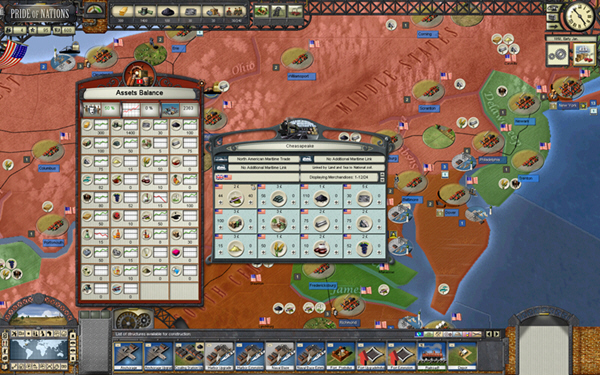
The zoomable map is divided into regions that can be aggregated into areas and theaters. Cities, economic areas, railroads, and troops are clearly shown. Clicking on these can bring up their respective modes as do shortcut keys. Regions change color along with the chosen mode. Twenty-six different filters provide even more information on revolt threat, supply, and spheres of influence. Mouse tool tips provide crucial information quickly. An interesting map asset is the overseas trade boxes in certain areas. Merchant fleets must be in these boxes to facilitate trade.
Clash of Steel
The combat system is very similar to other AGEOD games. The basic unit is the regiment with 48 different types of troops. Armies can be built up from regiments to division, corps and army levels by dropping icons on each other on the map or by moving them into tabs. Efficiency of units depends on officers who are rated with many attributes and four ranks. A corps commanded by a man fit for only divisional work will be very ineffective. Units themselves have 22 attributes shown by double clicking on their icon in the right-lower part of the screen. Movement is a simple click and drag but eight different postures can be given. Methods for transportation, changing organization, and commands or ordering different types of movement are accessed via several buttons. Uniforms and equipment are shown with period accuracy. Combat is conducted by clicking and dragging. Battle resolution is done during the simultaneous event stage with results shown on an initial screen and more details on a screen that players can choose to open.
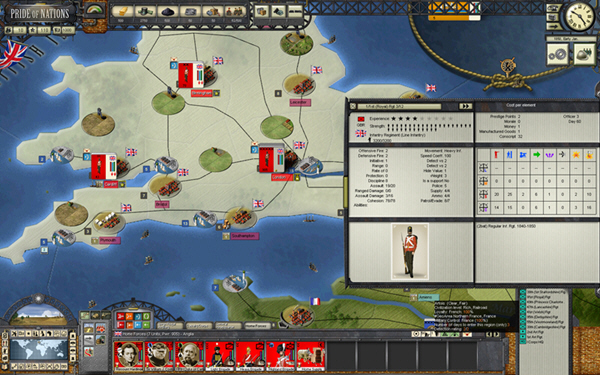
Colonial combat is tougher than set-piece battles. Native troops have a higher evasion value and the new, more stringent supply and weather rules make it more difficult to keep European troops effective in tropic climes. Building necessary depots to lengthen supply lines costs time and money and requires troops to garrison them against raids. Winning battles is more difficult when half of the troops are down with dengue fever. Native troops are fierce when fighting on their own terrain. Kipling was right; “wuzzie” was “a first-rate fighting man.”
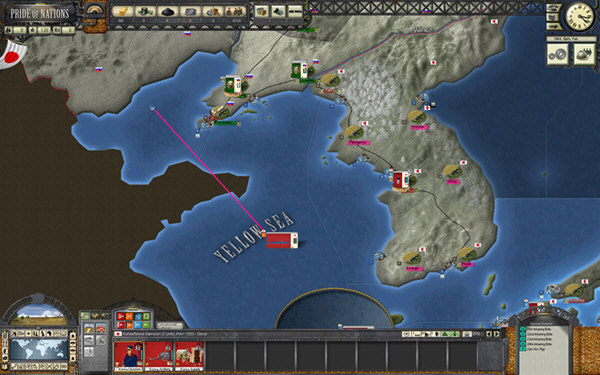
Naval combat mechanics are similar to land. However, players must keep an eye on fuel and repair facilities. Even light damage can send an important ship back to port. Unescorted transport flotillas are easy meat for the smallest raiders.
The Home Front
In every grand strategy game, the condition of the home country dictates military operations: Pride of Nations is no exception. National morale, economic health, domestic tranquility, and politics all have their place in the game. The context is set through four kinds of government from liberal democracy to tribal, national identity, levels of religious tolerance, types of social mobility, access to education, levels of conscription, and modes of bureaucracy. Countries with a whiff of democracy have both a head of state and a prime minister. Elections are held every four years for elected heads of state and two years for ministers. Players pick their favorite candidate and hopes the computer doesn’t stuff the ballot box. Hereditary rulers just die or have “accidents.” The heads of state and ministers are rated for imperialism, diplomacy, and administration with both their values combined. This value influences domestic and foreign affairs.
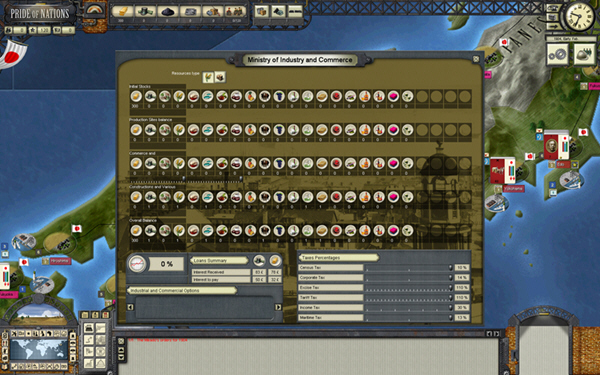
Keeping the populace happy at home and overseas happy is imperative. Seven factors make the contest of a population with each factor creating opportunities and friction. The relatively small populations early in the game makes cooptation simple but populations grow, increasing problems with social classes, religion, and ethnicity. Problems can cause production increase, riots, and revolts. These problems give rise to militancy and ugly crowds in the streets. Trouble can be headed off by giving the hoi-polloi more supplies but that tactic only works so far. One can always send in more police, march troops in, or declare martial law. Chances are cracking down will only worsen things, so changing policies in the decision mode is a good idea. Depending on the government type, the player may be able to cave into some of the populace’s demands.
The government’s values also determine its diplomacy abilities by determining the number of diplomats available and defining the relationship between countries. If relationships are good, making treaties and agreements is easier; if not, players must either work harder at being nice or start revving up the military. Twenty-six actions are possible but their availability depends on the size and organization of the country targeted. Sometimes border, influence, or trade disputes can cause a crisis. Countries then can have bilateral negotiations or call in a mediator.
Money and Other Peoples’ Land
Pride of Nations has a very deep economic and trade system. The elements involved are food, minerals, goods, state money, and private capital. The structures built contribute to the commercial zones by providing goods both domestically and international. Fleets in the sea trade boxes join overseas markets and depots. Keeping the domestic market full not only helps mange populaces but generate capital and several kinds of taxes. These monies stimulate investment in advanced structures, strengthen and maintain the military. and necessary technological research. After all, this period saw the explosion of science. Money also goads colonial yearnings. The technologic process is split between invention and technology, the former necessary for the latter. Advances can be sped up by investment of money and resources.
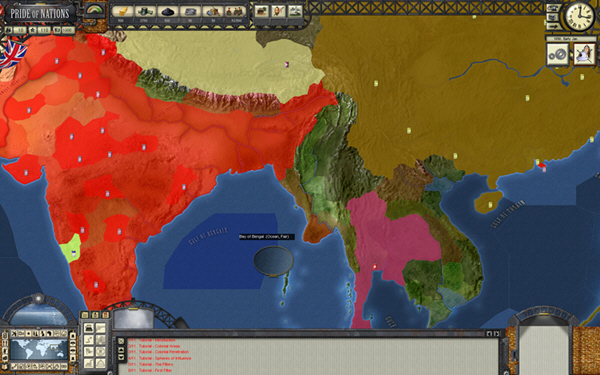
Colonization is not a mere matter of marching in and taking over but is a slow process beginning with trade, greasing the palms of local potentate, sending missionaries and infrastructure and the military. The actions used depend on the level of government of the target. Burma will not be bought with bangles and beads. Colonies can be rewarding in terms of resource and prestige. The downside is the ever-present risk of revolt and antagonizing other colonial powers.
The first step starts with expanding spheres of influence, a spreading ink spot process. Colonial penetration (calling Dr. Freud!) is accomplished through thirty actions such as scientific expeditions, building outposts and other ways of impressing the natives. Types of colonies range from influenced areas, protectorates, dominions and actual colonies, each with their own particular benefits and drawbacks. Colonies can be high maintenance, making them possibly detrimental in a larger sense.
Pride of Nations is an ambitious project and will be compared with Paradox’s real-time Victoria II. However, at first blush, AGEOD appears to be hitting all the bases of game elements, while providing a wide choice of interface selections. PBEM play could resemble a deeper version of Diplomacy. Due out in June, the finished product should be interesting.
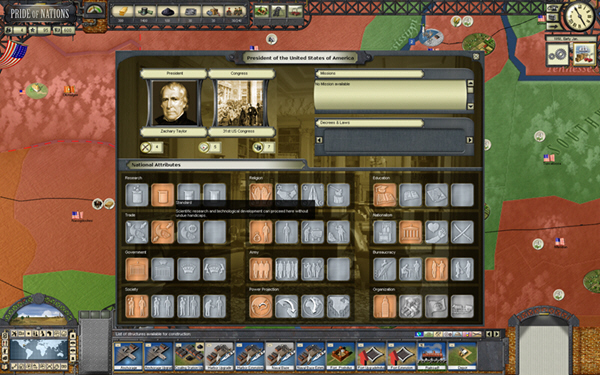
About the Author
Jim Cobb has been playing board wargames since 1961 and computer wargames since 1982. He has been writing incessantly since 1993 to keep his mind off the drivel he deals with as a bureaucrat. He has published in Wargamers Monthly, Computer Gaming World, Computer Games Magazine, Computer Games Online, CombatSim, Armchair General, Subsim, Strategyzone Online, Ganesquad and Gaming Chronicle.


Jim Cobb could use a good copy-editor…